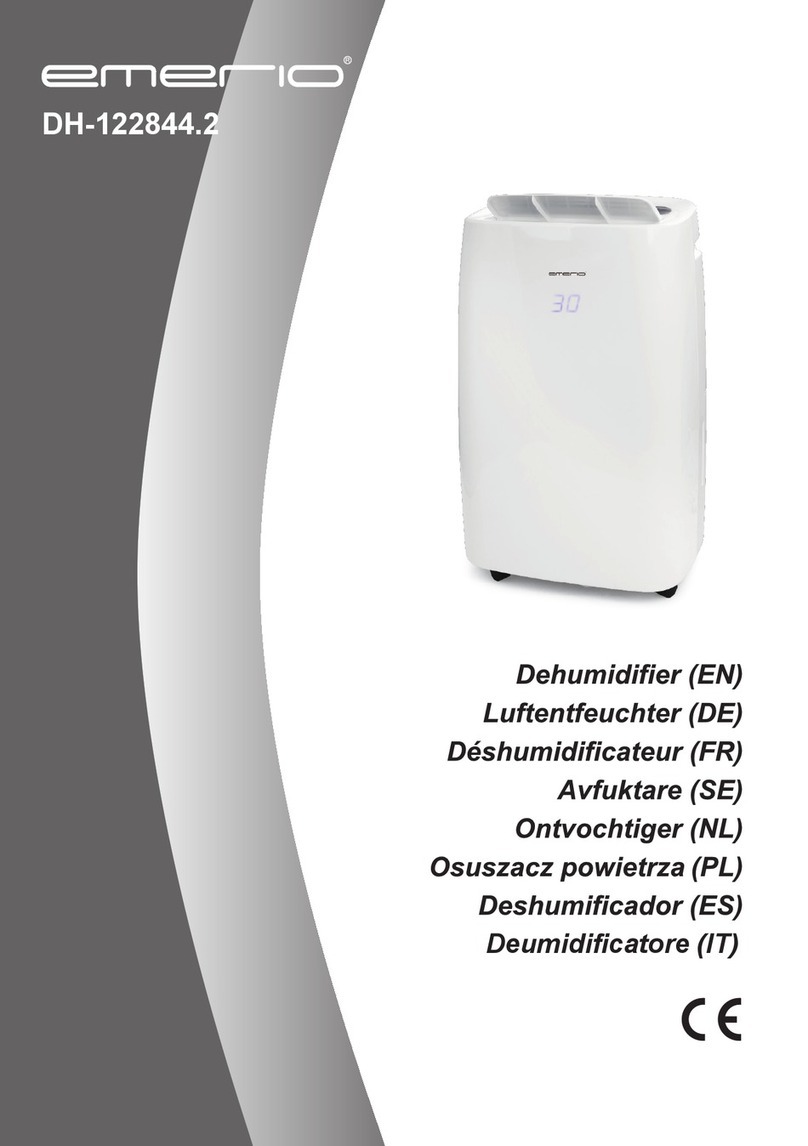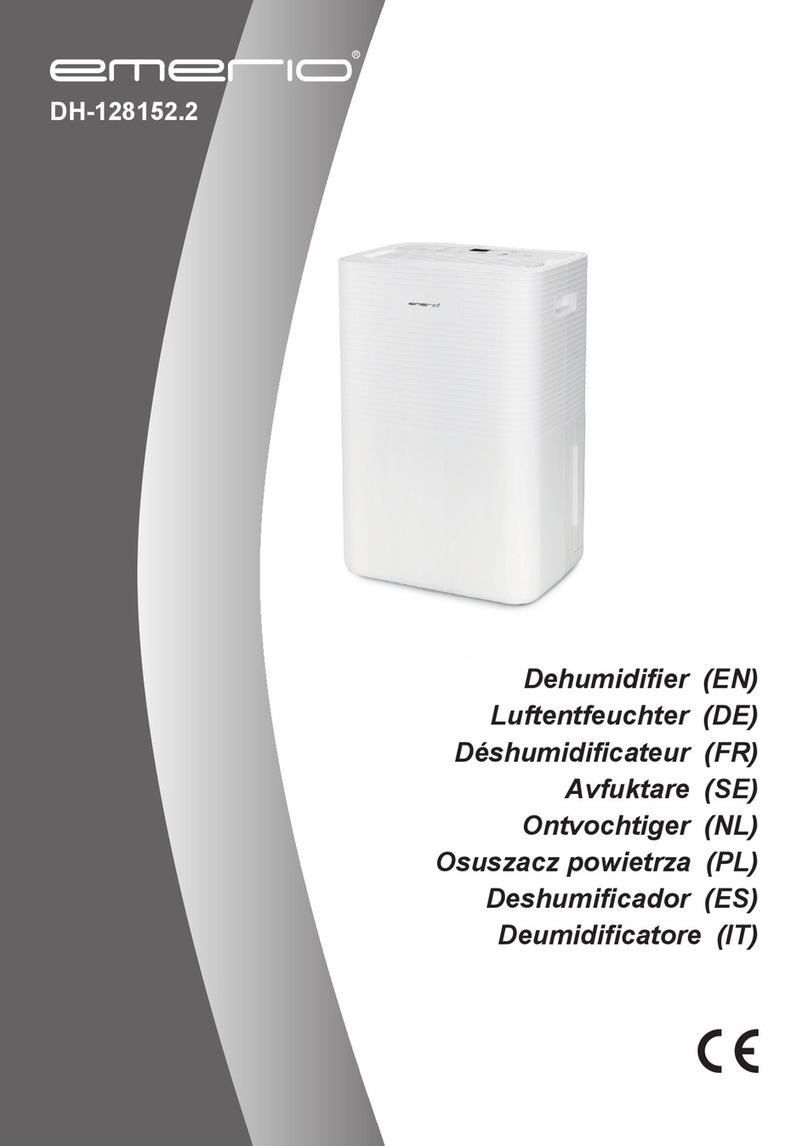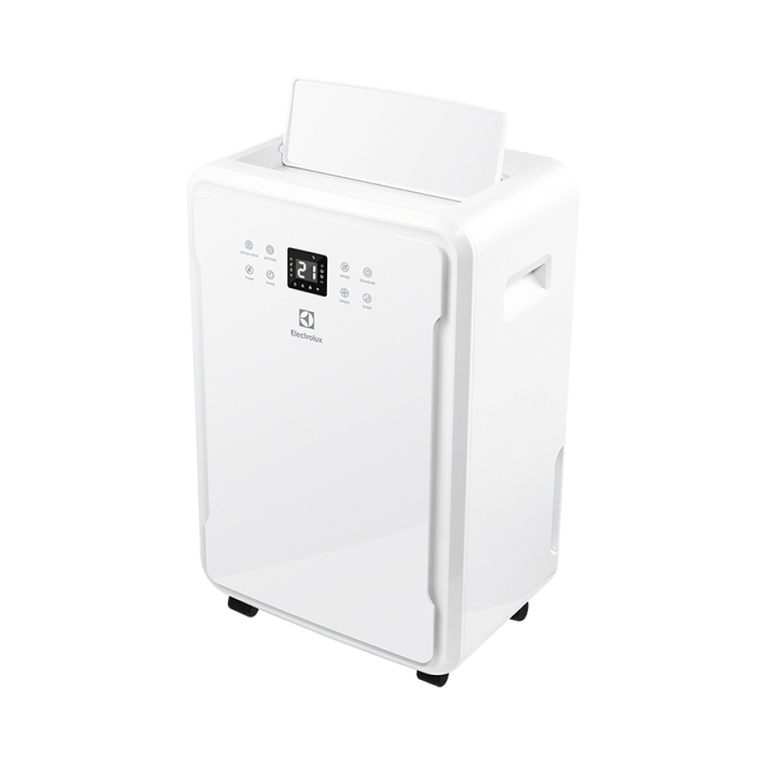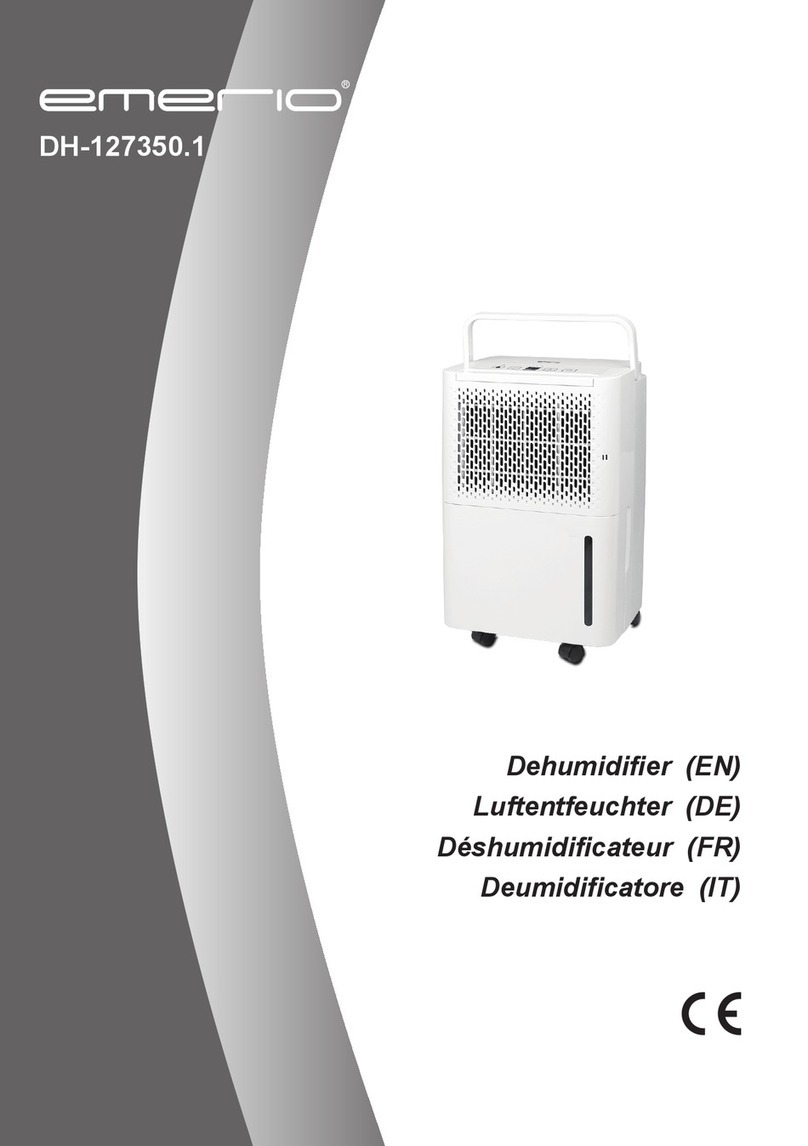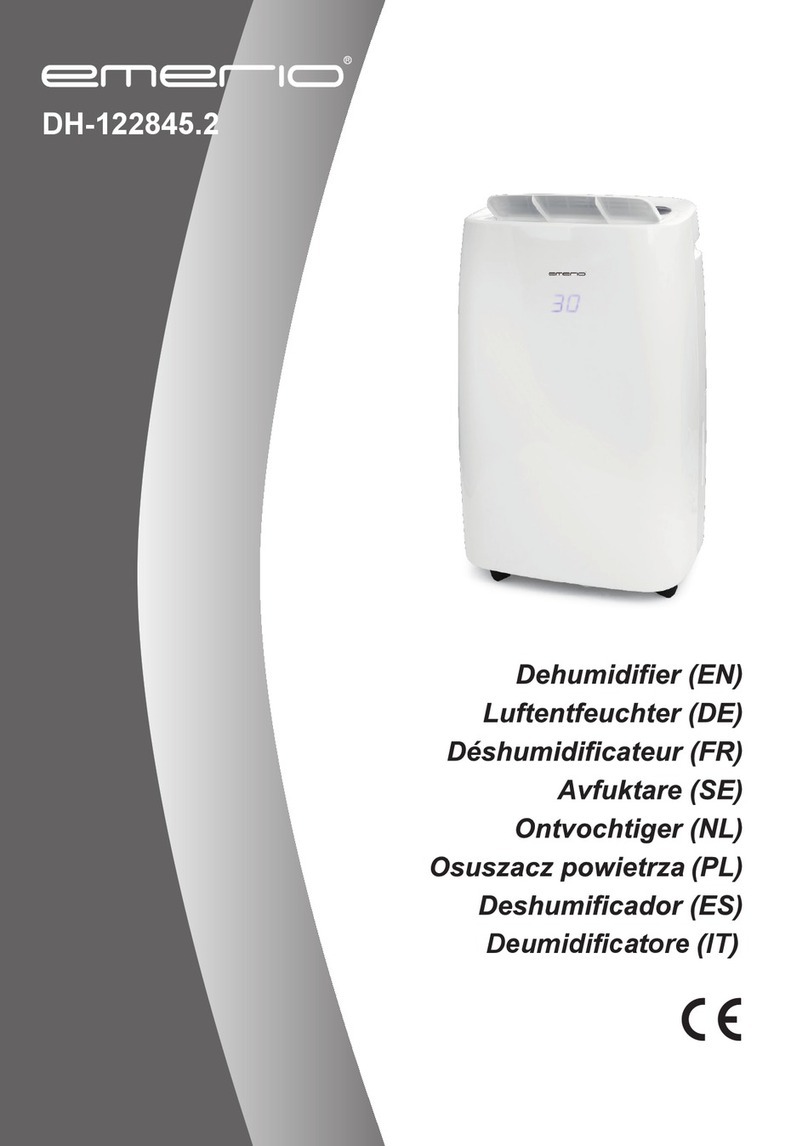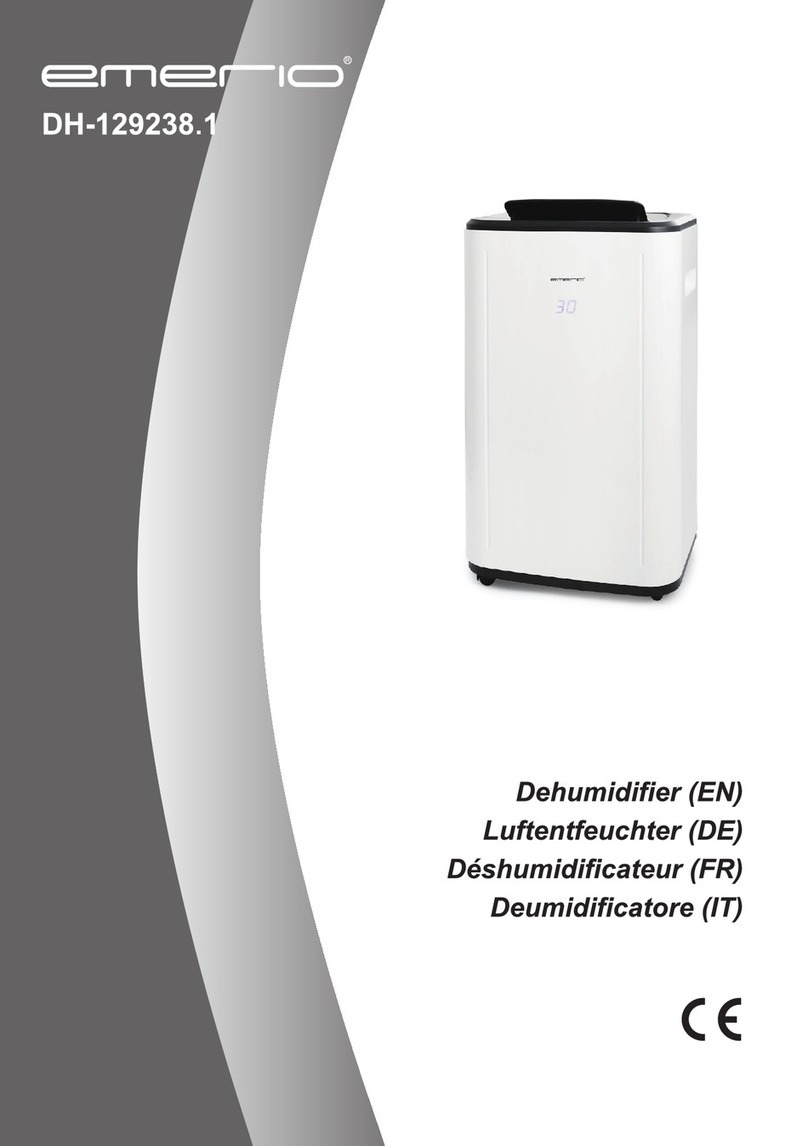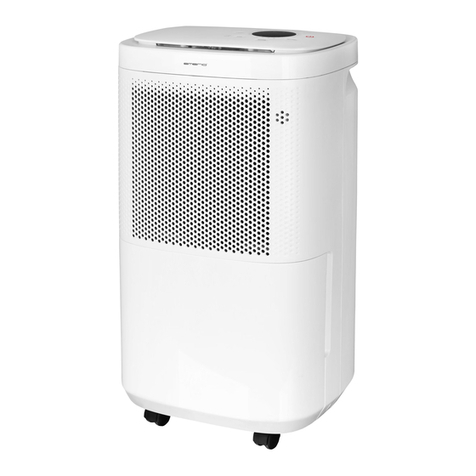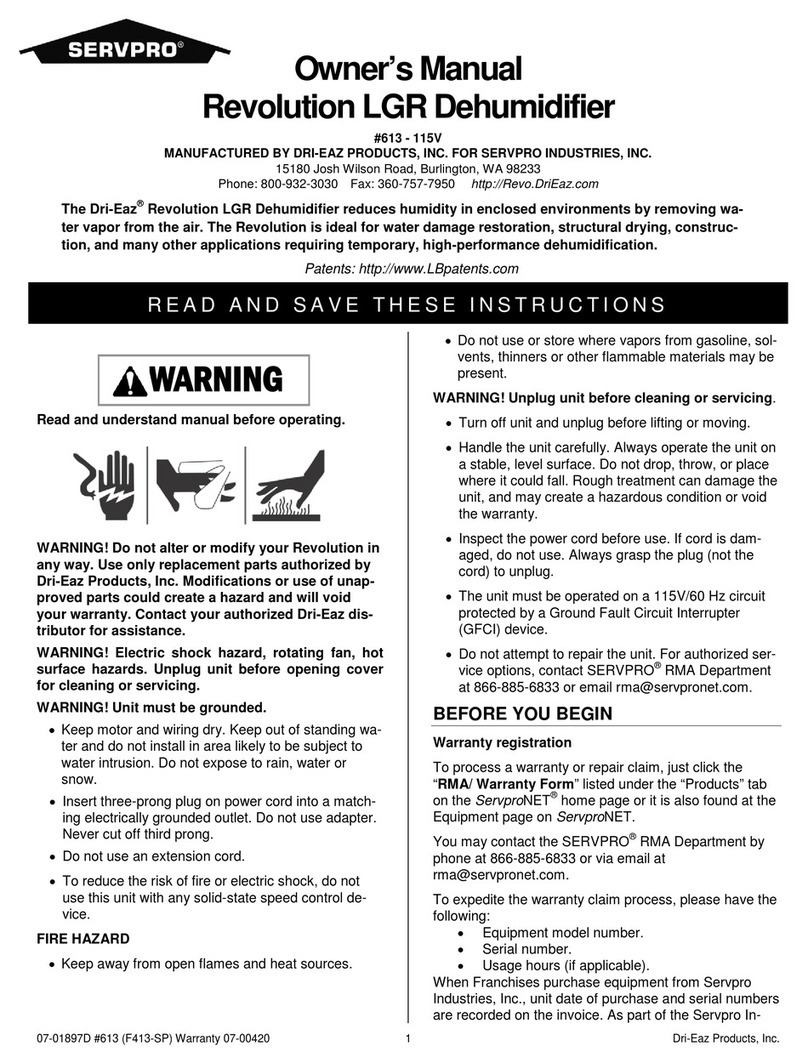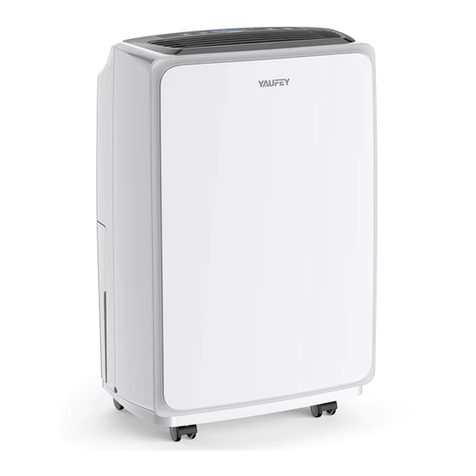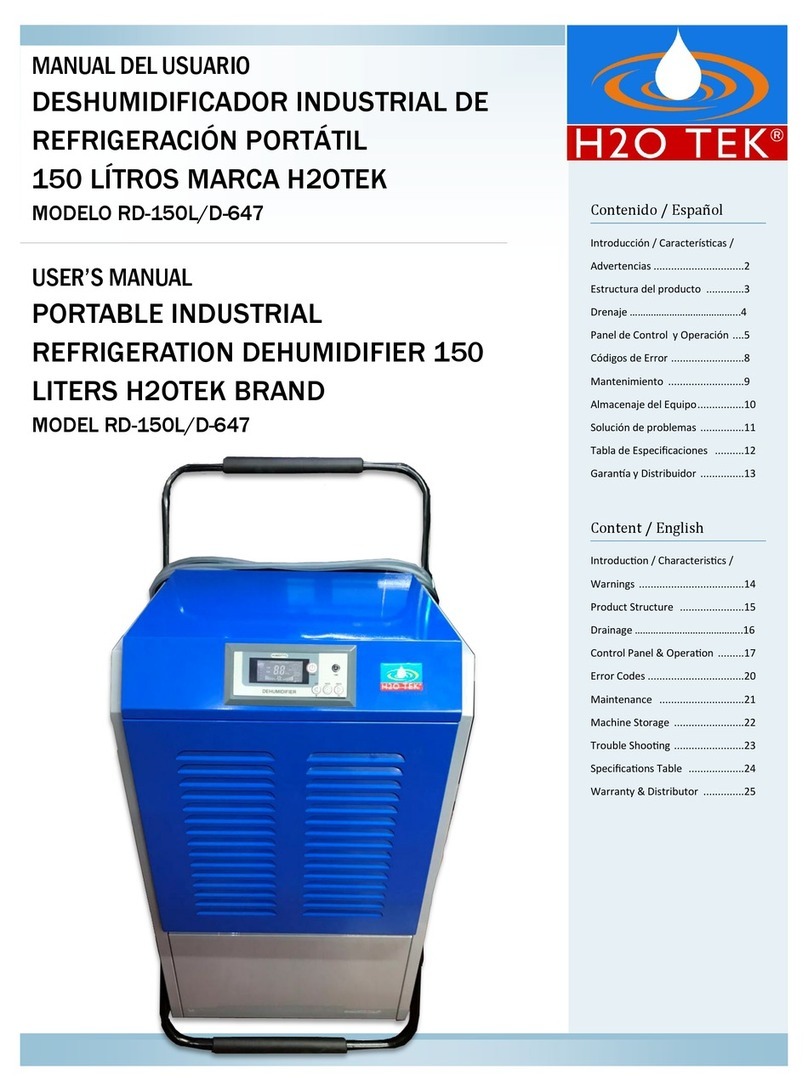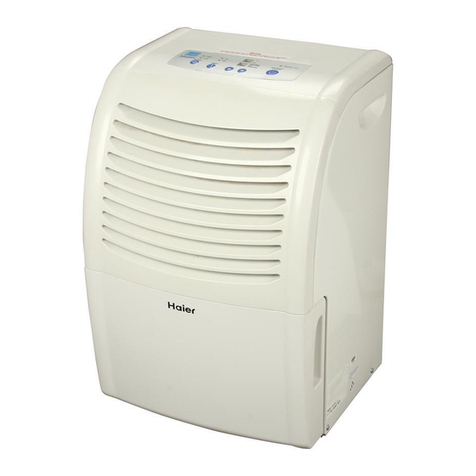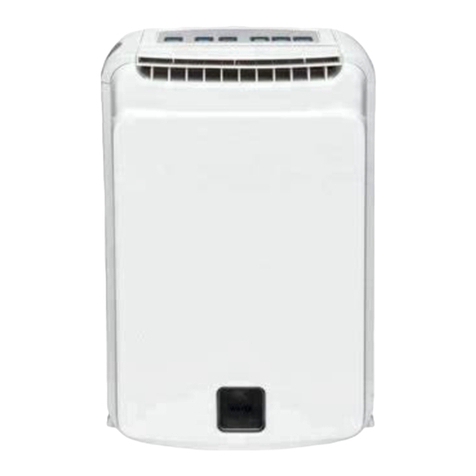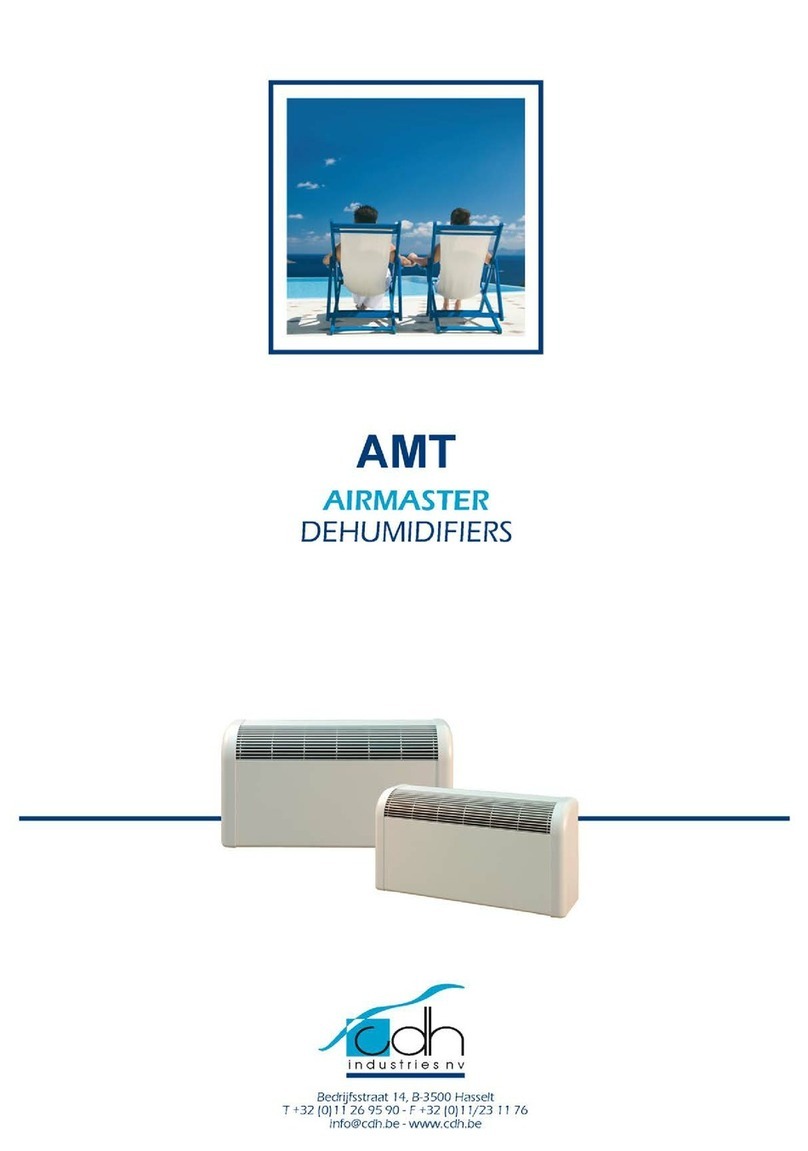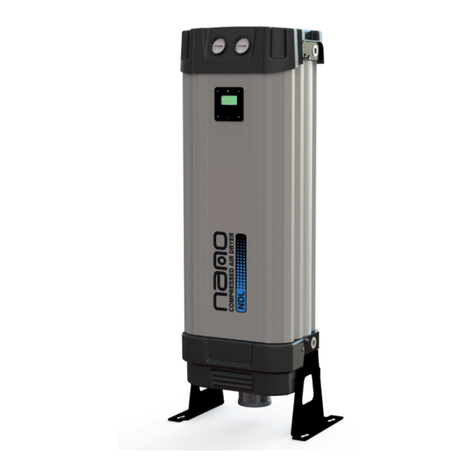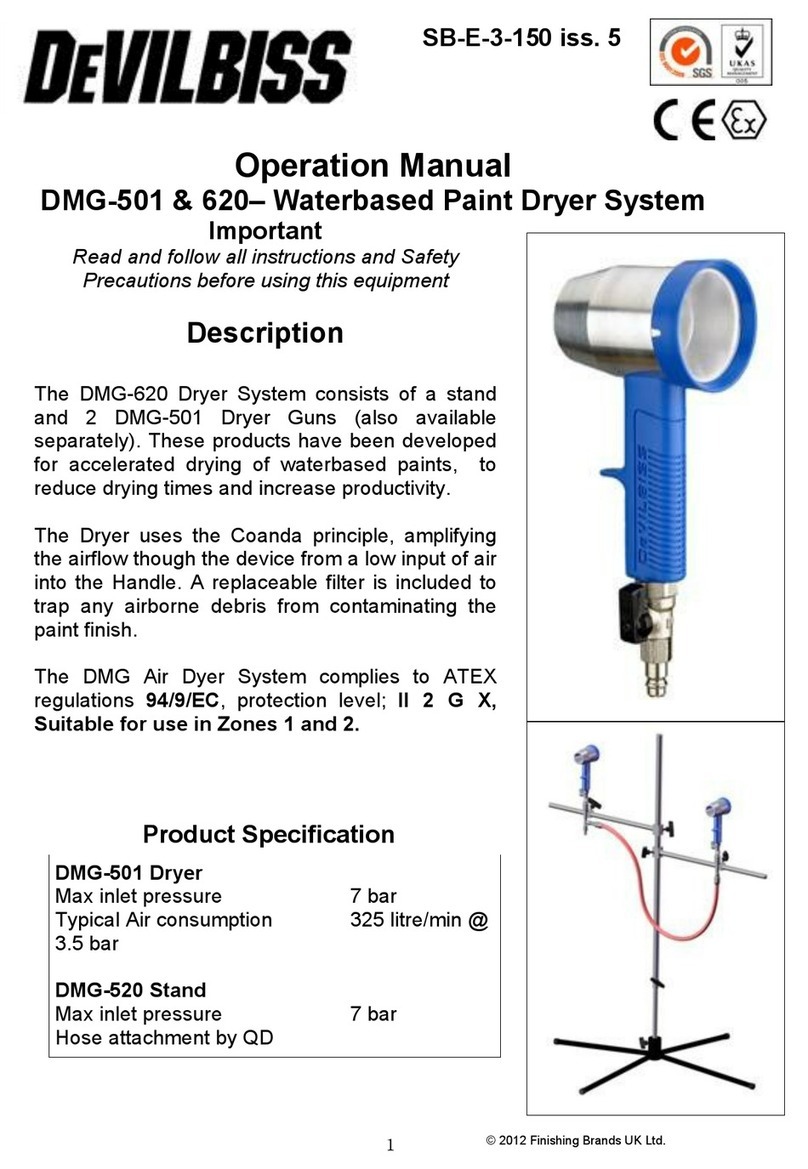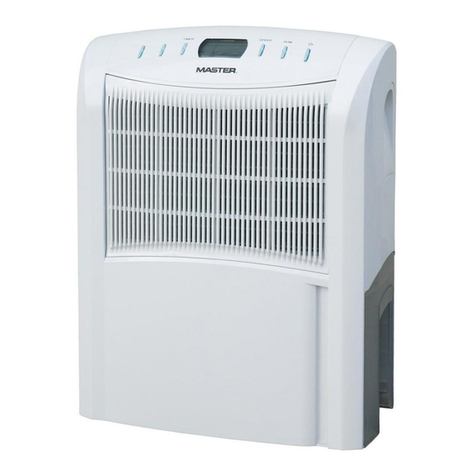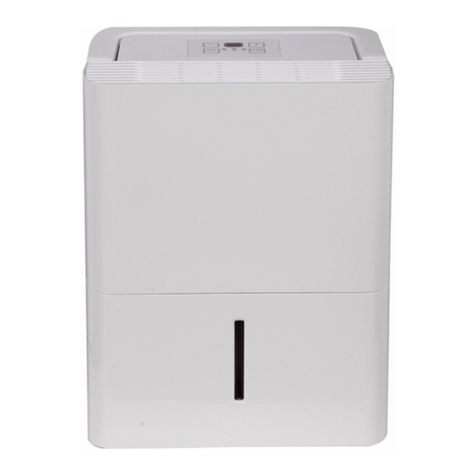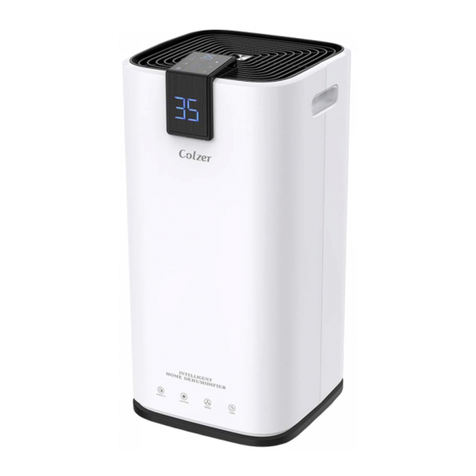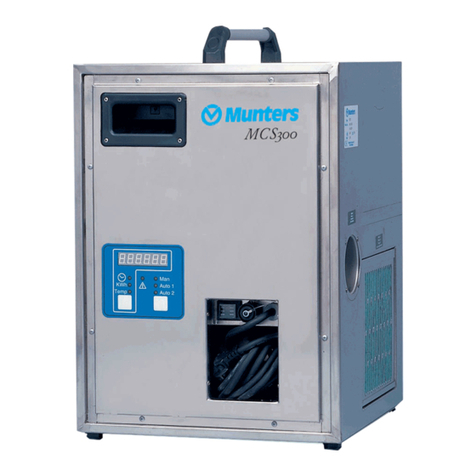emerio DH-127489.1 User manual


- 1 -
Content – Inhalt – Contenu – Contenuto
Instruction manual –English ....................................................................................... - 2 -
Bedienungsanleitung –Deutsch................................................................................ - 21 -
Mode d'emploi –Français ......................................................................................... - 42 -
Manuale d'istruzioni –Italiano.................................................................................. - 63 -

- 2 -
Instruction manual –English
SAFETY INSTRUCTIONS
Before use make sure to read all of the below instructions in
order to avoid injury or damage, and to get the best results
from the appliance. Make sure to keep this manual in a safe
place. If you give or transfer this appliance to someone else
make sure to also include this manual.
In case of damage caused by user failing to follow the
instructions in this manual the warranty will be void. The
manufacturer/importer accepts no liability for damages
caused by failure to follow the manual, a negligent use or use
not in accordance with the requirements of this manual.
1. Read and save these instructions. Attention: pictures in the
IM are for reference only.
2. This appliance can be used by children aged from 8 years
and above and persons with reduced physical, sensory or
mental capabilities or lack of experience and knowledge if
they have been given supervision or instruction concerning
use of the appliance in a safe way and understand the
hazards involved.
3. Children shall not play with the appliance.
4. Cleaning and user maintenance shall not be made by
children without supervision.
5. If the supply cord is damaged, it must be replaced by the
manufacturer, its service agent or similarly qualified
persons in order to avoid a hazard.
6. Before inserting the plug into the mains socket, please
check that the voltage and frequency comply with the
specifications on the rating label.
7. Always use a power outlet that is grounded.
8. Disconnect the mains plug from the socket when the
appliance is not in use and before cleaning.
9. Ensure that the mains cable is not hung over sharp edges
and keep it away from hot objects and open flames.

- 3 -
10. Do not immerse the appliance or the mains plug in water
or other liquids. There is danger to life due to electric shock!
11. To remove the plug from the plug socket, pull the plug. Do
not pull the power cord.
12. Do not touch the appliance if it falls into water. Remove the
plug from its socket and send it to an authorized service
center for repair.
13. Do not plug or unplug the appliance from the electrical
outlet with a wet hand.
14. Never attempt to open the housing of the appliance, or to
repair the appliance yourself. This could cause electric
shock.
15. Do not leave the appliance running unattended. Do not tilt
or turn over the appliance.
16. This appliance is not designed for commercial use. Indoor
use only.
17. Do not use the appliance for other than intended use.
18. Disconnect the power if strange sounds, smell or smoke
comes from it.
19. Switch off the appliance before changing its position.
20. Do not put heavy objects on the appliance.
21. Do not cover the intake or exhaust opening with cloths or
towels.
22. Do not take the water tank out during operation.
•Empty the water tank before moving the unit to avoid
water spilling.
•Do not tilt the unit to prevent water from spilling and
damaging the machine.
•Do not insert any foreign objects to enter any opening,
as this may cause an electric shock, fire or damage to the
appliance.
23. Do not put the unit close to heat-generating devices or near
flammable and dangerous materials.
24. Never put your fingers or objects into the air inlet or air
outlet.
25. Do not operate the dehumidifier in a closed area such as
inside a closet, as it may cause a fire.

- 4 -
26. The appliance shall be installed in accordance with national
wiring regulations.
27. Any person who is involved with working on or breaking
into a refrigerant circuit should hold a current valid
certificate from an industry-accredited assessment
authority, which authorizes their competence to handle
refrigerants safely in accordance with an industry,
recognized assessment specification.
28. Servicing shall only be performed as recommended by the
equipment manufacturer. Maintenance and repair
requiring the assistance of other skilled personnel shall be
carried out under the supervision of the person competent
in the use of flammable refrigerants.
29. Do not use means to accelerate the defrosting process or
to clean, other than those recommended by the
manufacturer.
30. The appliance shall be stored in a room without
continuously operating ignition sources (for example: open
flames, an operating gas appliance or an operating electric
heater.)
31. Do not pierce or burn.
32. Be aware that refrigerants may not contain an odour.
33. Pipe-work (inside the appliance) shall be protected from
physical damage and shall not be installed in an
unventilated space, if that space is smaller than 6m².
34. Compliance with national gas regulations shall be observed.
35. Do not touch the aluminum fins behind the air inlet.
36. Do not operate the appliance if it is dropped, damaged or
showing signs of product malfunction.
37. Do not clean the appliance with any chemicals.
38. The appliance must be stored in such a way as to prevent
mechanical failure.
39. To avoid any damage, place the appliance in an upright
position for at least 24 hours before initiation.
40. Regarding the instructions for repairing appliances
containing R290, please kindly refer to below paragraphs.

- 5 -
The environmentally friendly R290 is used as the refrigerant.
R290 has no damaging influence on the ozone layer (ODP), a
negligible greenhouse effect (GWP) and is available
worldwide. Because of its efficient energy properties, R290 is
highly suitable as a coolant for this application. Special
precautions must be taken into consideration due to the
coolant's high flammability.
The unit is designed only for use with R290 (propane) gas
as the designated refrigerant.
The refrigerant loop is sealed. Only a qualified technician
should attempt to service!
Do not discharge the refrigerant into the atmosphere.
R290 (propane) is flammable and heavier than air.
It collects first in low areas but can be circulated by the fans.
If propane gas is present or even suspected, do not allow
untrained personnel to attempt to find the cause.
The propane gas used in the unit has no odor.
The lack of smell does not indicate a lack of escaped gas.
If a leak is detected, immediately evacuate all persons from
the room, ventilate the room and contact the local fire
department to advise them that a propane leak has
occurred.
Do not let any persons go back into the room until the
qualified service technician has arrived and that technician
advises that it is safe to return to the room.
No open flames, cigarettes or other possible sources of
ignition should be used inside or in the vicinity of the unit.
Component parts designed for propane are non-incentive
and non-sparking. Component parts shall only be replaced
with identical repair parts.

- 6 -
Warning: Risk of fire / Flammable materials.
Read instruction manuals.
Operator’s manual; operating instructions.
Service indicator; read technical manual.
Warning: Keep ventilation openings clear of obstruction.
Warning: The appliance shall be stored in a well-ventilated
area where the room size corresponds to the room area as
specified for operation.
The required distance around the unit should be at least 30cm.
Appliance shall be operated and stored in a room with a floor
area larger than 6 m2.

- 7 -
DH-127489.1 EN
PARTS DESCRIPTION
1. Control panel
2. Air outlet
3. Handle
4. Water tank
5. Air inlet
6. Continuous drainage outlet
7. Storage place for power cord and plug
8. Drain hose
CONTROL PANEL
1. Power button
2. Mode button
3. Humidity/timer decreasing button
4. Humidity/timer increasing button
5. Wind speed button
6. Timer button
7. Power indicator light
8. Sleeping mode indicator light
9. Fan mode indicator light
10. Auto dehumidifying mode indicator light
11. Continuously drying mode indicator light
12. Temperature unit
13. Timer unit
14. Humidity unit
15. Digital display
16. Water full indicator light
17. High wind speed indicator light
18. Low wind speed indicator light
19. Timer indicator light

- 8 -
BEFORE FIRST USE
•To avoid any damage, place the appliance in an upright position for at least 24 hours before initiation.
•After removing the packaging, make sure that the appliance is in good condition.
•Do not allow children to play with the packaging materials as there is risk of suffocation.
The appliance shall be installed on a flat surface where the air inlet/outlet would not be blocked. The required
distance around the unit should be at least 30cm. To save energy, keep windows and door closed when the
appliance is running.
Never install the unit where it could be subject to:
Heat sources such as radiators, heat registers, stoves or other products that produce heat;
In an area where oil or water may be splashed;
Direct sunlight;
Mechanical vibration or shock;
Excessive dust;
Lack of ventilation, such as cabinet or bookcase;
Uneven surface.
Warning:
Install the unit in rooms which exceed 6 m².
Do not install the unit in a place where inflammable gas may leak.
Operating the device safely:
Operate this appliance in an ambient temperature from 5°C to 35°C.
Do not use outdoors. This appliance is intended for indoor residential applications only.
Do not operate this appliance in close proximity to walls, curtains, or other objects that may block inlet and
outlet.
Keep the air inlet and outlet free of obstacles.
Do not operate or store the unit in direct sunlight or rain.
It is normal for air outlet to feel warm to touch after continuous operation on hot days.
Empty the water tank before moving the appliance.
Make sure the water tank is correctly fitted otherwise the unit will not operate properly.
The appliance starts up in the mode selected when the unit was last used. There is a protective 3-minutes
time delay of the compressor. Wait 3 minutes for the appliance to resume dehumidification.

- 9 -
USE
1. Power button
Plug in the appliance, the machine will be in standby state. Press the power button, the power indicator light
will be on. Now users can press other buttons to choose the desired functions.
2. Mode button
Press this button to select your desired working mode; the corresponding indicator light will illuminate.
1) Auto dehumidifying mode:
When the ambient humidity>set humidity + 3%, the compressor and fan start working as selected.
When the ambient humidity<set humidity – 3%, the compressor stops working immediately and the
fan keeps working for approx. 30 seconds and then stops automatically.
Both wind speed and humidity can be adjusted under auto dehumidifying mode. After setting the
humidity the digital display will show back to the ambient humidity.
2) Continuously drying mode:
The appliance will run continuously and not be affected by the ambient humidity. Once the ambient
humidity reaches to 20% the appliance will stop automatically.
The wind speed can be adjusted under continuously drying mode and the digital display shows the
ambient humidity.
3) Sleeping mode:
The power indicator light and sleeping mode indicator light will turn dark; the other indicator lights and
digital display will be off if no further operations in approx. 10 seconds. Other functions are the same as
the auto dehumidifying mode.
4) Fan mode:
The humidity cannot be set and the compressor is not working.
The wind speed can be adjusted and the digital display shows the ambient humidity.
3. Humidity/timer increasing button and humidity/timer decreasing button
The set humidity can be adjusted from 30-80%.
The timer can be adjusted from 0-24h.
Note: long press the humidity/timer increasing button to check the ambient temperature.
4. Wind speed button
Press this button to switch the wind speed between low wind speed and high wind speed.
5. Timer button
Press this button to set the timer, check the timer or cancel the timer.
1) Set the timer:
Press this button to enter the timer setting state. The digital display will flash the timer value.
Press the button “+”/”-” to adjust your desired timer from 0-24h.
2) Check the timer or cancel the timer:
Once the timer has been set, users can press this button to check the remaining time of the timer.
Continue to press this button again the timer will be cancelled.
Note:
When the appliance is working set the timer to turn off the appliance.
When the appliance is standby set the timer to turn on the appliance.

- 10 -
INTELLIGENT DEFROSTING
When the temperature is too low, frost may form inside the machine. The machine will automatically start
defrosting with the indicator light of mode button flashing. The compressor will work intermittently, and
automatically exit the defrost mode after finishing defrosting.
DRAINAGE
Emptying the water tank
When the tank is full, the unit will turn off and make a buzzing sound. The water full indicator light will turn
on and the digital display will show "FL".
Pull out the water tank. Empty the water in it.
Clean the inside of the water tank as well as the outside.
Replace the empty water tank back into the unit.
If the water full indicator light does not extinguish, check that the float is correctly in place.
Warning
1. Do not discard the float or the plastic rivet. Otherwise, the machine will not automatically stop working when
the water tank is full, and the condensed water will overflow and damage the floor of the room.
2. Please be sure to clean the condensed water in the water tank before resetting the working mode of the
machine.
3. If the water tank is dirty, rinse it with clean water. Avoid using detergents, steel balls, chemical dust removers,
diesel oil, benzene, diluents or other solvents. Otherwise, the water tank will be damaged and leaked.
4. Replace the empty water tank back into the unit. Otherwise, the water full indicator light may remain red
and the machine cannot restart.
Remove the handle
from the water tank.
Remove the cover.
Check the float.
Plastic rivet
Float

- 11 -
Continuous draining
For continuous operation, please connect the provided drain hose to the unit. Condensate water can be
automatically flowed into a bucket or drained by gravity.
1. Remove the water tank from the unit. Take down the black rubber plug from position (A) and then insert it
into the downward water outlet (B). Put back the water tank into the unit.
Thus, the water will flow out from the drainage hole instead of into the water tank.
2. Straighten the drain hose. Remove the cover of the continuous drainage hole.
3. Insert one end of the drain hose into the hole and connect the other end to the bathroom, outdoors or
bucket like a container, or the prescribed drainage area.
Important! Please pour away the water timely when use a bucket in case the water overflows and damages the
floor of the room.
Remember to replace the black rubber plug to position (A) if you want to use back the water tank to catch the
water.
Warning
1. Please do not block the drain hose. If blocked, condensed water will flow into the water tank.
2. Please do not bend the drain hose. The height of the drain hose should be lower than the outlet.
3. The drain hose shall be securely connected to the outlet.
CLEANING AND MAINTENANCE
The appliance must be regularly cleaned to prolong its life and keep it functioning properly.
Warning: Before performing any cleaning, turn off the unit and unplug it to avoid electrical shocks. Do not use
hot water or chemical solvents for cleaning.
1. Regularly, clean the water tank with cold or warm water and dry with a soft cloth to avoid any mildew.
2. Clean the surface of the appliance using a moist cloth. Do not use detergents or abrasive sponges that can
cause damage to the plastic surface.
3. Clean the filter as described in the following section.
4. When the unit will not be used for a long time:
1) Empty and dry the water tank, and then install it back.
2) Clean the filter.
3) Place the appliance upright and avoid the direct sunlight.

- 12 -
Cleaning the air filter (every two weeks)
Dust collects on the filter and restricts the airflow. The restricted airflow reduces the efficiency of the system and
if it becomes blocked it can cause damage to the unit.
The air filter requires regular cleaning. The air filter is removable for easy cleaning. Do not operate the unit
without an air filter, or the evaporator may be contaminated.
1. Pull out the filter from the rear of the appliance.
2. Use a vacuum cleaner to gently absorb the dust on the surface. If the filter is very dirty, wash it with water
and a soft detergent and dry it thoroughly afterwards.
3. Put the filter back.
TROUBLE SHOOTING
1. Functioning temperature
5°C ≤ Ambient Temperature ≤ 35°C
When the ambient temperature is lower or higher than the functioning temperature, the dehumidifier stops.
When the ambient temperature is low, the compressor automatically defrosts at intervals; during defrosting, the
compressor stops and the fan keeps running.
2. Before calling for service
Before contacting professional service, please review the trouble shooting list that includes common occurrences
that are not the result of a defect in workmanship or materials.
Problem
Possible Cause
Solution
No working
Whether the power plug is connected
Plug in
Whether the water tank is full
Empty the water tank
Whether the water tank is in position
Place it well
Room temperature ˂ 5°C, or ˃ 35 °C
It’s the self-protection designed to protect
the unit. The machine cannot work under
such temperature.
Small dehumidifying
capacity
Is the filter clogged?
Clean the filter
Is the air inlet or air outlet
obstructed?
Remove the obstruction from the air outlet
or air inlet.
Big noises
Whether the appliance is placed well
Place the appliance on a smooth and stable
floor
Is the filter clogged?
Clean the filter
E1
Humidity sensor problem
Change a sensor

- 13 -
LO
Environmental humidity is below 20%
The dehumidifier shuts down for self-
protection
HI
Environmental humidity is above 90%
Once the humidity drops, the error code will
disappear.
CL
Low temperature protection; the
environmental temperature ˂ 5°C
The dehumidifier shuts down for self-
protection
CH
High temperature protection; the
environmental temperature ˃ 38 °C
The dehumidifier shuts down for self-
protection
STORAGE
Long-term storage - If you will not be using the unit for an extended period of time (more than a few weeks) it is
best to clean the unit and dry it out completely. Please store the unit per the following steps:
1. Switch off and unplug the unit.
2. Drain the remaining water from the unit.
3. Clean the filter and let the filter dry completely in a shaded area.
4. Collect the power cord at the storage place.
5. Re-install the filter at its position.
6. The unit must be kept in upright position when in storage.
7. Put the machine in ventilating, dry, non-corrosive gas and safe place indoors.
Attention:
The evaporator inside the machine has to be dried out before the unit is packed to avoid component damage
and molds. Unplug the unit and place it in a dry open area for days to dry it out. Another way to dry the unit is
to set the appliance to the fan mode to dry the evaporator for a couple of hours.
TECHNICAL DATA
Dehumidify Capacity
30L/D (27℃, RH60%)
50L/D (30℃, RH80%)
Rated Voltage
AC 220-240V
Rated Frequency
50Hz
Rated input power
685W
Max. rated input power
793W
Refrigerant
R290
GUARANTEE AND CUSTOMER SERVICE
Before delivery our devices are subjected to rigorous quality control. If, despite all care, damage has occurred
during production or transportation, please return the device to your dealer. In addition to statutory legal rights,
the purchaser has an option to claim under the terms of the following guarantee:
For the purchased device we provide 2 years guarantee, commencing from the day of sale. If you have a defective
product, you can directly go back to the point of purchase.
Defects which arise due to improper handling of the device and malfunctions due to interventions and repairs
by third parties or the fitting of non-original parts are not covered by this guarantee. Always keep your receipt,
without the receipt you can’t claim any form of warranty. Damage caused by not following the instruction manual,
will lead to a void of warranty, if this results in consequential damages then we will not be liable. Neither can we
hold responsible for material damage or personal injury caused by improper use if the instruction manual is not
properly executed. Damage to accessories does not mean free replacement of the whole appliance. In such case
please contact our service department. Broken glass or breakage of plastic parts is always subject to a charge.
Defects to consumables or parts subjected to wearing, as well as cleaning, maintenance, replacement of said
parts or shipping and transportation costs to and from any place of repair are not covered by the warranty and
are to be paid.

- 14 -
ENVIRONMENT FRIENDLY DISPOSAL
Recycling – European Directive 2012/19/EU
This marking indicates that this product should not be disposed with other household wastes. To
prevent possible harm to the environment or human health from uncontrolled waste disposal, recycle
it responsibly to promote the sustainable reuse of material resources. To return your used device,
please use the return and collection systems or contact the retailer where the product was purchased. They can
take this product for environmentally safe recycling.
Emerio Switzerland AG
Oberneuhofstrasse 1
6340 Baar
Switzerland

- 15 -
INSTRUCTIONS FOR REPAIRING APPLIANCES CONTAINING R290
1. Servicing
1) Checks to the area
Prior to beginning work on systems containing flammable refrigerants, safety checks are necessary to ensure
that the risk of ignition is minimised. For repair to the refrigerating system, the following precautions shall be
complied with prior to conducting work on the system.
2) Work procedure
Work shall be undertaken under a controlled procedure so as to minimise the risk of a flammable gas or vapour
being present while the work is being performed.
3) General work area
All maintenance staff and others working in the local area shall be instructed on the nature of work being carried
out. Work in confined spaces shall be avoided. The area around the workspace shall be sectioned off. Ensure that
the conditions within the area have been made safe by control of flammable material.
4) Checking for presence of refrigerant
The area shall be checked with an appropriate refrigerant detector prior to and during work, to ensure the
technician is aware of potentially flammable atmospheres. Ensure that the leak detection equipment being used
is suitable for use with flammable refrigerants, i.e. non-sparking, adequately sealed or intrinsically safe.
5) Presence of fire extinguisher
If any hot work is to be conducted on the refrigeration equipment or any associated parts, appropriate fire
extinguishing equipment shall be available to hand. Have a dry powder or CO₂ fire extinguisher adjacent to the
charging area.
6) No ignition sources
No person carrying out work in relation to a refrigeration system which involves exposing any pipe work that
contains or has contained flammable refrigerant shall use any sources of ignition in such a manner that it may
lead to the risk of fire or explosion. All possible ignition sources, including cigarette smoking, should be kept
sufficiently far away from the site of installation, repairing, removing and disposal, during which flammable
refrigerant can possibly be released to the surrounding space. Prior to work taking place, the area around the
equipment is to be surveyed to make sure that there are no flammable hazards or ignition risks. “No Smoking”
signs shall be displayed.
7) Ventilated area
Ensure that the area is in the open or that it is adequately ventilated before breaking into the system or
conducting any hot work. A degree of ventilation shall continue during the period that the work is carried out.
The ventilation should safely disperse any released refrigerant and preferably expel it externally into the
atmosphere.
8) Checks to the refrigeration equipment
Where electrical components are being changed, they shall be fit for the purpose and to the correct specification.
At all times the manufacturer’s maintenance and service guidelines shall be followed. If in doubt consult the
manufacturer’s technical department for assistance.
The following checks shall be applied to installations using flammable refrigerants:
– The charge size is in accordance with the room size within which the refrigerant containing parts are installed;
– The ventilation machinery and outlets are operating adequately and are not obstructed;
– If an indirect refrigerating circuit is being used, the secondary circuit shall be checked for the presence of
refrigerant;
– Marking to the equipment continues to be visible and legible. Markings and signs that are illegible shall be
corrected;
– Refrigeration pipe or components are installed in a position where they are unlikely to be exposed to any
substance which may corrode refrigerant containing components, unless the components are constructed of

- 16 -
materials which are inherently resistant to being corroded or are suitably protected against being so corroded.
9) Checks to electrical devices
Repair and maintenance to electrical components shall include initial safety checks and component inspection
procedures. If a fault exists that could compromise safety, then no electrical supply shall be connected to the
circuit until it is satisfactorily dealt with. If the fault cannot be corrected immediately but it is necessary to
continue operation, an adequate temporary solution shall be used. This shall be reported to the owner of the
equipment so all parties are advised. Initial safety checks shall include:
• That capacitors are discharged: this shall be done in a safe manner to avoid possibility of sparking;
• That there no live electrical components and wiring are exposed while charging, recovering or purging the
system;
• That there is continuity of earth bonding.
2. Repairs to sealed components
1) During repairs to sealed components, all electrical supplies shall be disconnected from the equipment being
worked upon prior to any removal of sealed covers, etc. If it is absolutely necessary to have an electrical supply
to equipment during servicing, then a permanently operating form of leak detection shall be located at the most
critical point to warn of a potentially hazardous situation.
2) Particular attention shall be paid to the following to ensure that by working on electrical components, the
casing is not altered in such a way that the level of protection is affected. This shall include damage to cables,
excessive number of connections, terminals not made to original specification, damage to seals, incorrect fitting
of glands, etc.
Ensure that apparatus is mounted securely. Ensure that seals or sealing materials have not degraded such that
they no longer serve the purpose of preventing the ingress of flammable atmospheres. Replacement parts shall
be in accordance with the manufacturer’s specifications.
NOTE: The use of silicon sealant may inhibit the effectiveness of some types of leak detection equipment.
Intrinsically safe components do not have to be isolated prior to working on them.
3. Repair to intrinsically safe components
Do not apply any permanent inductive or capacitance loads to the circuit without ensuring that this will not
exceed the permissible voltage and current permitted for the equipment in use. Intrinsically safe components
are the only types that can be worked on while live in the presence of a flammable atmosphere. The test
apparatus shall be at the correct rating. Replace components only with parts specified by the manufacturer.
Other parts may result in the ignition of refrigerant in the atmosphere from a leak.
4. Cabling
Check that cabling will not be subject to wear, corrosion, excessive pressure, vibration, sharp edges or any other
adverse environmental effects. The check shall also take into account the effects of aging or continual vibration
from sources such as compressors or fans.
5. Detection of flammable refrigerants
Under no circumstances shall potential sources of ignition be used in the searching for or detection of refrigerant
leaks. A halide torch (or any other detector using a naked flame) shall not be used.
6. Leak detection methods
The following leak detection methods are deemed acceptable for systems containing flammable refrigerants.
Electronic leak detectors shall be used to detect flammable refrigerants, but the sensitivity may not be adequate,
or may need re-calibration. (Detection equipment shall be calibrated in a refrigerant-free area.) Ensure that the
detector is not a potential source of ignition and is suitable for the refrigerant used. Leak detection equipment

- 17 -
shall be set at a percentage of the LFL of the refrigerant and shall be calibrated to the refrigerant employed and
the appropriate percentage of gas (25 % maximum) is confirmed. Leak detection fluids are suitable for use with
most refrigerants but the use of detergents containing chlorine shall be avoided as the chlorine may react with
the refrigerant and corrode the copper pipe-work. If a leak is suspected, all naked flames shall be removed/
extinguished. If a leakage of refrigerant is found which requires brazing, all of the refrigerant shall be recovered
from the system, or isolated (by means of shut off valves) in a part of the system remote from the leak. Oxygen
free nitrogen (OFN) shall then be purged through the system both before and during the brazing process.
7. Removal and evacuation
When breaking into the refrigerant circuit to make repairs – or for any other purpose – conventional procedures
shall be used. However, it is important that best practice is followed since flammability is a consideration. The
following procedure shall be adhered to:
• Remove refrigerant;
• Purge the circuit with inert gas;
• Evacuate;
• Purge again with inert gas;
• Open the circuit by cutting or brazing.
The refrigerant charge shall be recovered into the correct recovery cylinders. The system shall be “flushed” with
OFN to render the unit safe. This process may need to be repeated several times. Compressed air or oxygen shall
not be used for this task. Flushing shall be achieved by breaking the vacuum in the system with OFN and
continuing to fill until the working pressure is achieved, then venting to atmosphere, and finally pulling down to
a vacuum. This process shall be repeated until no refrigerant is within the system. When the final OFN charge is
used, the system shall be vented down to atmospheric pressure to enable work to take place. This operation is
absolutely vital if brazing operations on the pipe-work are to take place. Ensure that the outlet for the vacuum
pump is not close to any ignition sources and there is ventilation available.
8. Charging procedures
In addition to conventional charging procedures, the following requirements shall be followed.
– Ensure that contamination of different refrigerants does not occur when using charging equipment. Hoses or
lines shall be as short as possible to minimise the amount of refrigerant contained in them.
– Cylinders shall be kept upright.
– Ensure that the refrigeration system is earthed prior to charging the system with refrigerant.
– Label the system when charging is complete (if not already).
– Extreme care shall be taken not to overfill the refrigeration system.
Prior to recharging the system it shall be pressure tested with OFN. The system shall be leak tested on completion
of charging but prior to commissioning. A follow up leak test shall be carried out prior to leaving the site.
9. Decommissioning
Before carrying out this procedure, it is essential that the technician is completely familiar with the equipment
and all its detail. It is recommended good practice that all refrigerants are recovered safely. Prior to the task
being carried out, an oil and refrigerant sample shall be taken in case analysis is required prior to re-use of
reclaimed refrigerant. It is essential that electrical power is available before the task is commenced.
a) Become familiar with the equipment and its operation.
b) Isolate system electrically.
c) Before attempting the procedure ensure that:
• Mechanical handling equipment is available, if required for handling refrigerant cylinders;
• All personal protective equipment is available and being used correctly;
• The recovery process is supervised at all times by a competent person;

- 18 -
• Recovery equipment and cylinders conform to the appropriate standards.
d) Pump down refrigerant system, if possible.
e) If a vacuum is not possible, make a manifold so that refrigerant can be removed from various parts of the
system.
f) Make sure that cylinder is situated on the scales before recovery takes place.
g) Start the recovery machine and operate in accordance with manufacturer's instructions.
h) Do not overfill cylinders. (No more than 80 % volume liquid charge).
i) Do not exceed the maximum working pressure of the cylinder, even temporarily.
j) When the cylinders have been filled correctly and the process completed, make sure that the cylinders and the
equipment are removed from site promptly and all isolation valves on the equipment are closed off.
k) Recovered refrigerant shall not be charged into another refrigeration system unless it has been cleaned and
checked.
10. Labelling
Equipment shall be labelled stating that it has been de-commissioned and emptied of refrigerant. The label shall
be dated and signed. Ensure that there are labels on the equipment stating the equipment contains flammable
refrigerant.
11. Recovery
When removing refrigerant from a system, either for servicing or decommissioning, it is recommended good
practice that all refrigerants are removed safely. When transferring refrigerant into cylinders, ensure that only
appropriate refrigerant recovery cylinders are employed. Ensure that the correct number of cylinders for holding
the total system charge is available. All cylinders to be used are designated for the recovered refrigerant and
labelled for that refrigerant (i.e. special cylinders for the recovery of refrigerant). Cylinders shall be complete
with pressure relief valve and associated shut-off valves in good working order. Empty recovery cylinders are
evacuated and, if possible, cooled before recovery occurs. The recovery equipment shall be in good working
order with a set of instructions concerning the equipment that is at hand and shall be suitable for the recovery
of flammable refrigerants. In addition, a set of calibrated weighing scales shall be available and in good working
order. Hoses shall be complete with leak-free disconnect couplings and in good condition. Before using the
recovery machine, check that it is in satisfactory working order, has been properly maintained and that any
associated electrical components are sealed to prevent ignition in the event of a refrigerant release. Consult
manufacturer if in doubt. The recovered refrigerant shall be returned to the refrigerant supplier in the correct
recovery cylinder, and the relevant Waste Transfer Note arranged. Do not mix refrigerants in recovery units and
especially not in cylinders. If compressors or compressor oils are to be removed, ensure that they have been
evacuated to an acceptable level to make certain that flammable refrigerant does not remain within the lubricant.
The evacuation process shall be carried out prior to returning the compressor to the suppliers. Only electric
heating to the compressor body shall be employed to accelerate this process. When oil is drained from a system,
it shall be carried out safely.
Competence of service personnel
General
Special training additional to usual refrigerating equipment repair procedures is required when equipment with
flammable refrigerants is affected.
In many countries, this training is carried out by national training organisations that are accredited to teach the
relevant national competency standards that may be set in legislation.
The achieved competence should be documented by a certificate.
Training
The training should include the substance of the following:

- 19 -
Information about the explosion potential of flammable refrigerants to show that flammables may be dangerous
when handled without care.
Information about potential ignition sources, especially those that are not obvious, such as lighters, light switches,
vacuum cleaners, electric heaters.
Information about the different safety concepts:
Unventilated – Safety of the appliance does not depend on ventilation of the housing. Switching off the appliance
or opening of the housing has no significant effect on the safety. Nevertheless, it is possible that leaking
refrigerant may accumulate inside the enclosure and flammable atmosphere will be released when the enclosure
is opened.
Ventilated enclosure – Safety of the appliance depends on ventilation of the housing. Switching off the appliance
or opening of the enclosure has a significant effect on the safety. Care should be taken to ensure a sufficient
ventilation before.
Ventilated room – Safety of the appliance depends on the ventilation of the room. Switching off the appliance
or opening of the housing has no significant effect on the safety. The ventilation of the room shall not be switched
off during repair procedures.
Information about the concept of sealed components and sealed enclosures according to IEC 60079-15:2010.
Information about the correct working procedures:
a) Commissioning
• Ensure that the floor area is sufficient for the refrigerant charge or that the ventilation hose is assembled in a
correct manner.
• Connect the pipes and carry out a leak test before charging with refrigerant.
• Check safety equipment before putting into service.
b) Maintenance
• Portable equipment shall be repaired outside or in a workshop specially equipped for servicing units with
flammable refrigerants.
• Ensure sufficient ventilation at the repair place.
• Be aware that malfunction of the equipment may be caused by refrigerant loss and a refrigerant leak is possible.
• Discharge capacitors in a way that won’t cause any spark. The standard procedure to short circuit the capacitor
terminals usually creates sparks.
• Reassemble sealed enclosures accurately. If seals are worn, replace them.
• Check safety equipment before putting into service.
c) Repair
• Portable equipment shall be repaired outside or in a workshop specially equipped for servicing units with
flammable refrigerants.
• Ensure sufficient ventilation at the repair place.
• Be aware that malfunction of the equipment may be caused by refrigerant loss and a refrigerant leak is possible.
• Discharge capacitors in a way that won’t cause any spark.
• When brazing is required, the following procedures shall be carried out in the right order:
– Remove the refrigerant. If the recovery is not required by national regulations, drain the refrigerant to the
outside. Take care that the drained refrigerant will not cause any danger. In doubt, one person should guard the
outlet. Take special care that drained refrigerant will not float back into the building.
– Evacuate the refrigerant circuit.
– Purge the refrigerant circuit with nitrogen for 5 min.
– Evacuate again.
– Remove parts to be replaced by cutting, not by flame.
– Purge the braze point with nitrogen during the brazing procedure.
– Carry out a leak test before charging with refrigerant.
• Reassemble sealed enclosures accurately. If seals are worn, replace them.
Table of contents
Languages:
Other emerio Dehumidifier manuals
